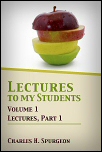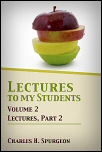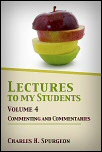Lectures to My Students (4 vols.)
Digital Logos Edition
Overview
Charles Spurgeon is one of the church’s most famous preachers and Christianity’s most prolific writers. During his decades-long ministry in nineteenth century England, Spurgeon preached thousands of sermons, heard by millions of listeners. He devoted his life to the clear exposition of the Bible, and led the Metropolitan Tabernacle to become the largest church of its time. More than one hundred years after his death, Charles Spurgeon continues to exert powerful influence in the church and around the world. He remains a model preacher for pastors of every age.
Lectures to My Students contains the ultimate how-to guide for preachers. It covers the basics of preaching, the use of illustrations, the mechanics of sermon delivery, and much more. Volume 4 contains Commentary and Commentaries, one of the most cited reference works on Bible commentaries, with notes and background information for thousands of volumes of Scripture commentaries.

- Four volumes of guides on sermon preperation
- Explains use of illustrations and mechanics of sermon delivery
- Notes and background information on thousands of volumes of Scripture commentaries
- Ideal for pastors and laity
I think the word ‘indefatigable’ was created for people like Charles Spurgeon.
- Title: Lectures to My Students
- Author: Charles Spurgeon
- Volumes: 4
- Pages: 1,007
This title is included in the following collections
You can save when you purchase this product as part of a collection.
Logos 8 Baptist Bronze Legacy ...
$89.99$89.99Logos 6 Baptist Bronze Legacy ...
$89.99$89.99Logos 5 Baptist Bronze Legacy ...
$89.99$89.99Sermon Editor Collection (34 r...
$209.99$209.99
- $349.99$279.99
- $349.99
- $349.99
- $349.99
- $399.99
- $849.99$679.99
- $1,577.53$784.99
- $849.99
- $849.99
- $849.99
- $849.99
- $1,499.99$1,199.99
- $1,499.99
- $1,499.99
- $1,499.99
- $1,499.99
- $1,499.99
- $2,999.99$2,249.99
- $2,999.99$2,249.99
- $2,999.99
- $2,999.99
- $2,999.99
- $2,999.99
- $2,999.99
- $2,999.99
- $2,999.99
- $2,999.99
- $4,749.99$3,562.49
- $4,749.99$3,562.49
- $4,749.99
- $4,749.99
- $4,749.99
- $4,749.99
- $4,749.99
- $4,749.99
- $4,749.99
- $4,749.99
- $4,749.99
- $12,102.39$7,299.99
- $11,399.99
- $11,399.99
- $11,399.99
- $23,999.99$17,999.99
- $21,749.99
- $24,999.99

In Lectures to My Students, Spurgeon has written the ultimate how-to guide for preachers. This volume covers the basics of preaching, such as the nuts-and-bolts of choosing a text and composing a sermons. Spurgeon, the master orator, also advises students on the mechanics of spontaneous sermons and impromptu speech, admitting that such a talent takes time and effort. He also laments that pastors often find themselves out of place—“speckled birds,” in his words—unable to conduct themselves in ordinary social circumstances. This practical guide will be of enormous benefit to pastors and preachers.

Spurgeon compiled a second volume of Lectures in response to the overwhelmingly positive reception of his first volume. This volume contains detailed lectures on the role of the Holy Spirit during sermon preparation and delivery. Spurgeon also writes at length about the practical mechanics of sermon delivery, such as vocal inflection, hand gestures, eye contact, and attention to posture.

Volume three of Spurgeon’s Lectures teaches preachers how to use illustrations and stories within their sermons. Preaching, at its most basic level, helps the congregation find their place in the narrative arc of Scripture, making storytelling an integral component. This volume reveals Spurgeon’s method of artfully integrating illustrations and stories into his sermons, along with other creative ways to make the text come alive. That thousands returned each week to hear Spurgeon preach testifies to the remarkable success of Spurgeon’s method.

Commenting and Commentaries, the fourth volume of Spurgeon’s Lectures to My Students, has become one of the most widely accessed and cited reference works on Bible commentaries. Spurgeon judged too many sermons as “flashy, rather than fleshy; clever, rather than solid; entertaining, rather than impressive.” He pleaded for more expository preaching, and for more preachers equipped to expound the Word. Spurgeon compiled this volume of commentaries to help preachers select and employ commentaries for the study of Scripture and the preaching of the World.
Spurgeon was a voracious reader. During his lifetime, he read thousands of books and acquired familiarity with astounding number of commentators. This volume contains notes and background information for thousands of volumes of commentary on Scripture, along with detailed introductions to many of the most important commentators, including Matthew Henry, John Calvin, Matthew Poole, John Trapp, John Gill, Adam Clarke, Albert Barnes, John Kitto, John Albert Bengel, Henry Alford, and others. He also urges pastors to read diligently, and use concordances wisely. This practical volume is a must-have for pastors, teachers, and anyone seeking a guide to the countless volumes written on Scripture.
Charles Haddon Spurgeon was born in Kelvedon, Essex, England on June 19, 1834. He converted to Christianity in 1850 at a small Methodist chapel, to which he detoured during a snowstorm. While there, he heard a sermon on Isaiah 45:22 and was saved—“Look unto me, and be ye saved, all the ends of the earth, for I am God, and there is none else.” He began his own ministry of preaching and teaching immediately, and preached more than 500 sermons by the age of twenty.
In 1854, at nineteen years of age, Spurgeon began preaching at the New Park Street Chapel in London. He was appointed to a six month trial position, which he requested be cut to three months should the congregation dislike his preaching. He gained instant fame, however, and the church grew from 232 members to more than five thousand at the end of his pastorate. Many of his sermons were published each week and regularly sold more than 25,000 copies in twenty languages. Throughout his ministry, Spurgeon estimated that he preached to more than 10,000,000 people. Dwight L. Moody was deeply influenced by Spurgeon’s preaching, and founded the Moody Bible Institute after seeing Spurgeon’s work at the Pastor’s College in London.
Spurgeon read six books per week during his adult life, and read Pilgrim’s Progress more than 100 times. In addition to his studying and preaching, Spurgeon also founded the Pastor’s College (now Spurgeon’s College), various orphanages and schools, mission chapels, and numerous other social institutions.
Charles Spurgeon suffered from poor health throughout his life. He died on January 31, 1892, and was buried in London.
Reviews
18 ratings

David Anfinrud
3/23/2024
I am playing around with this one. I bought it on wordsearch and got transfered to Logos for me. I do think this is one for those thinking of the ministry to work thru all 30 Lectures. The first one is extremely Important for those thinking of the Ministry. The issues in Spurgeon's time are similar to Those we fact today. Temptations can destroy a ministry. I also have been playing around with having Logos play the audio for me a few bugs in it. But if you start it and do not change the reading you can listen to the LEcture one at a time. I usually like listening and reading at the same time.Kevin Yarian
2/22/2017
Alfredo Hinojosa, Jr.
12/5/2016

Debra W Bouey
7/29/2016
John M Brown
4/27/2015
This set was instrumental for me during my early Bible college years. The truths Spurgeon shares are timeless.
Dr. Rich J. Sironen
10/27/2014

Simon Villeneuve
8/18/2014

Matthew John Buttner
5/26/2014

Jonathan Ray
1/22/2014